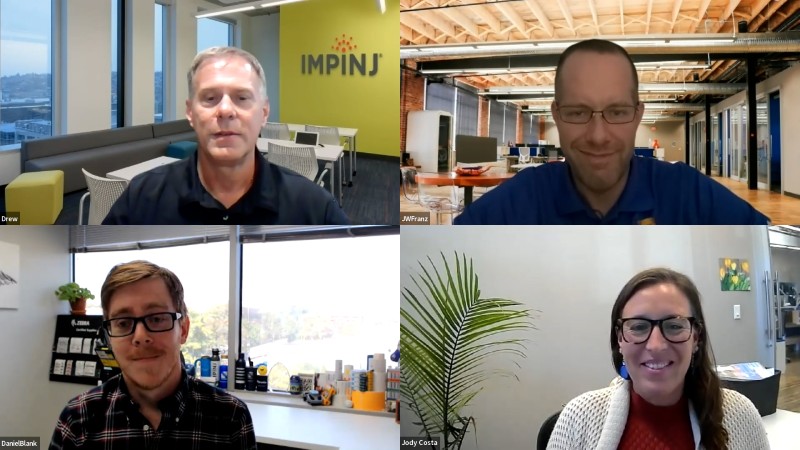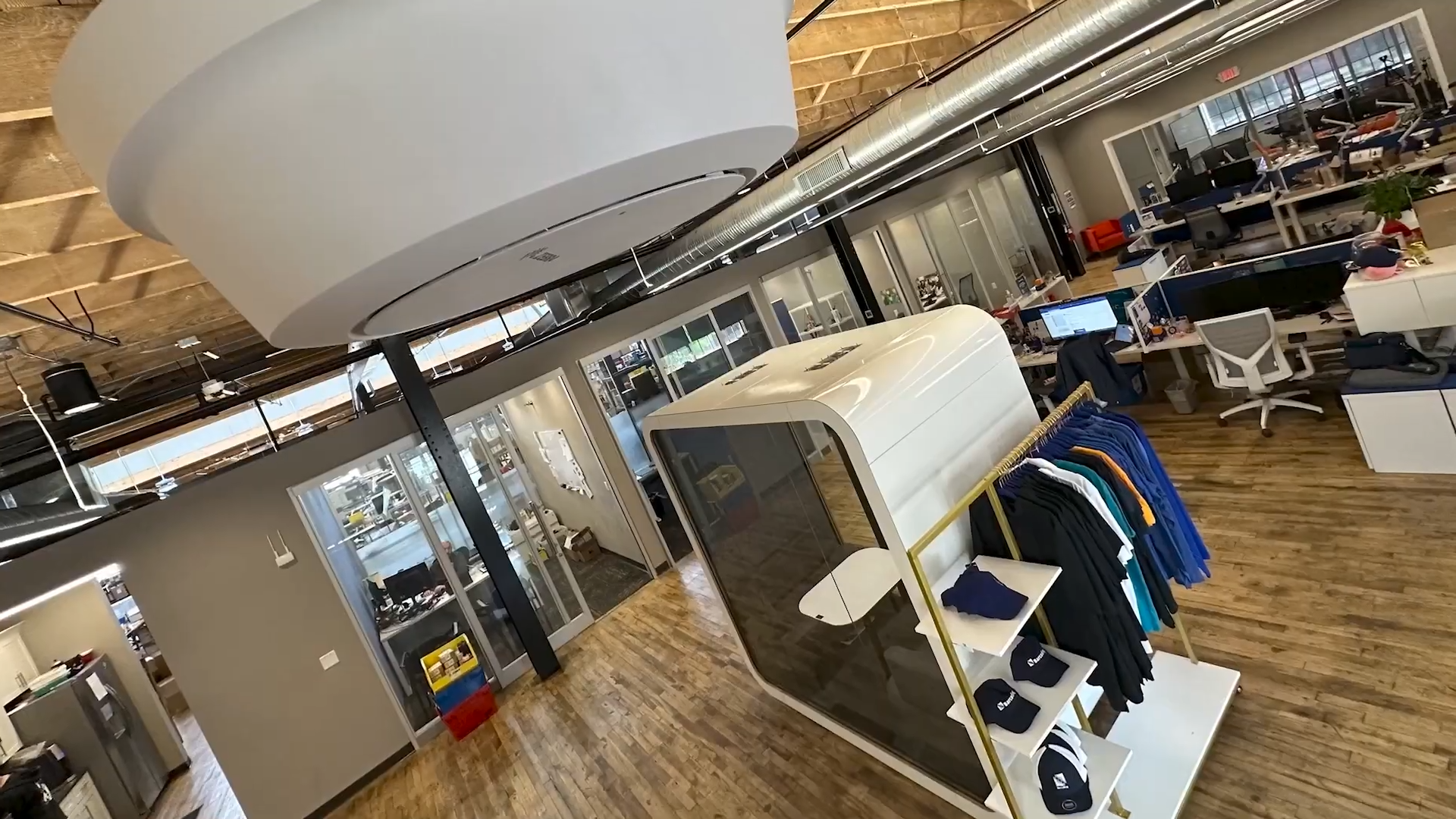Since Walmart and other big-box retailers have begun mandating the use of RAIN RFID tags and labels on products sold in stores, vendors have scrambled to implement the required tags.
But, along with meeting an obligation, suppliers and service providers also face a new question:
Where could RAIN RFID create opportunities within their own operations for improved accuracy, efficiency, and speed?
This month’s Huddle covers why, when, and how RAIN RFID makes sense from an ROI perspective, and what to expect as more users integrate multiple technologies into their inventory and asset management systems. Read the overview for selected insights from these experts:
- Jody Costa, Vice President of Marketing and Strategic Partnerships, Barcoding
- Dan Blank, Director of Label and Printing Solutions, Barcoding
- JW Franz, Director of IoT, Barcoding
- Drew Gassiot, Sales Director, Impinj
Want a deeper dive? Just check out the video!
Before diving into all the potential use cases for RFID throughout the supply chain, it’s vital to understand what RAIN RFID is (and what it’s not), and how it works in conjunction with IoT-connected devices, sensors, and software.
In a recent survey by Impinj and Supply Chain Dive, 83% of respondents said they have adopted or are currently in the process of implementing IoT-based technologies in their processes.
What is RAIN RFID?
RAIN RFID (radio frequency identification) is a passive ultrahigh frequency RFID technology that uses specialized tags and labels, or embedded RAIN RFID tags in the item itself or in its packaging, to provide item-level identification. The tags can be “read” by devices, including handheld scanners, IoT-connected gates, beacons, tunnels, and more. These connected devices identify items, retrieve information from the database, and update or add new information.
The combination of tags and readers, software, and databases enable item-level data capture to identify, locate, authenticate, and interact with items at any point in the supply chain. Because RAIN RFID and IoT-connected devices introduce new opportunities for data collection and automation, they make a whole new level of visibility and efficiency possible, including:
- Near real-time product location, whether in-store, in a DC, or along the supply chain
- Faster and more accurate cycle counting
- Preventing and documenting shipment discrepancies to improve compliance
- Tighter control over processes and chain of custody
- Tracking high-value assets
- RTI tracking and waste reduction
What isn’t RAIN RFID? It’s not an obligatory, system-wide “upgrade.” Many businesses worry that RFID advancements are rendering their barcode-based inventory management systems obsolete. In fact, the two technologies are often complementary and integrated into processes together.
Companies That Comply With RFID Mandates Face Fresh Opportunities
So, how can big-box suppliers make the most of retailer RFID mandates? As long as suppliers are making the investment in the tags and/or labels, it’s often worth revisiting processes to see whether strategically placed, IoT-connected sensors could help those companies capture useful data. Cost savings that Barcoding and Impinj customers have seen include:
- Labor and labor management reductions
- Tremendous time savings for shipment verification
- Fast, accurate cycle counting
- Reductions in claims, charge-backs, and ripple-out costs associated with shipping errors
RFID’s Biggest Superpower: One-to-One Versus One-to-Many
Consider the capability of one sensor to read many RFID tags at once, or one worker’s ability to perform an entire retail department’s cycle count instead of a full team. That level of accuracy, speed, and efficiency is what RAIN RFID and IoT are all about. In a distribution center environment, the faster data can be handled and moved, the faster products can move.
At the dock door, that means virtually instantaneous shipment verification with RAIN RFID versus manual barcode scanning that requires line-of-sight access. No one-by-one handling of each pallet and no need for the forklift operator to get on and off the equipment. Shipments don’t just move faster; they move with fewer errors. That can mean reduced fines, penalties, chargebacks, and savings on extended costs of errors like fuel, energy, storage, labor, time, and customer satisfaction.
Inventory Management & Cycle Counting
Stores that implement RAIN RFID-based inventory management often achieve upward of 95% accuracy in their cycle counts, compared with non-RFID industry averages around 65%. That level of visibility means retailers have a more accurate view of inventory than ever before—just what’s needed to respond to the demands of omnichannel distribution. And the speed and labor reductions mean they can count more often, further increasing cycle count accuracy and usefulness. No more day-long store closures or special inventory teams.
Theft Prevention & Inventory Control
Within DC and retail, item-level product status can be accessed and updated at theoretically any point as the product moves through the environment. Using connected gates and sensors, it’s possible to know when an item leaves a store department, passes through a checkout, and leaves the store after having been paid for. Automation makes it possible to detect when items leave locations without being paid for, too.
That capability could help retailers and suppliers quickly discover and respond to sources of shrinkage, assuming all products are tagged at the item level. While item-level tagging for even low-cost items may sound overwhelming, the justification all comes down to ROI, and the right data can quickly deliver meaningful results.
Asset Tracking & RTIs
Companies that use closed-loop assets like reusable transport items (pallets, totes, drums, crates, etc.) benefit from monitoring assets’ location, condition, and partner compliance for returns. But those aren’t the only assets that can be tracked. Tools, laboratory equipment, calibrated devices, durable medical equipment, and many other high-value and regulated assets can be much more closely monitored.
In the food industry, as technologies evolve to incorporate condition monitoring (such as temperature, humidity, and impact), connected RTIs can help make food safety and track-and-trace programs even more robust.
High-ROI Use Cases
In cases involving high-value items, heavily regulated industries, and product safety concerns, RAIN RFID’s potential is easy to see. Capturing and documenting processes for quality management, product tracking, and ingredient tracing are all areas where fast, automated data capture can help eliminate error and increase transparency.
Take the highly regulated cannabis market as an example. RAIN RFID tags, plant stakes, or labels enable cannabis companies to track each unique plant from seed to store, maintaining chain-of-custody integrity and product traceability for both safety and enforcement monitoring.
With RFID, item-level serialization becomes possible. So, instead of the same UPC code applied to items, a RAIN RFID tag can identify each item with its own unique identifier. In the case of a product recall, speed, efficiency, and accuracy can help businesses respond better.
Uniquely Engineered Solutions Are Often Needed
Many operations are best served with more than one data capture technology in a system. It could be passive RAIN RFID combined with active RFID, or RFID meeting a specialized need within a barcode-based inventory management system.
Some products (liquids and metals) may not be great candidates for RAIN RFID. In other cases, environments may pose a challenge. In those cases, it makes sense to integrate systems using more than one data capture technology. Any solution needs to be properly implemented and applied. That takes expertise.
Does the big-box RFID mandate present new opportunities for your operations to gain accuracy, efficiency, and speed? Find out when you download our free guide to retailer mandates. Just click below to get your copy.








